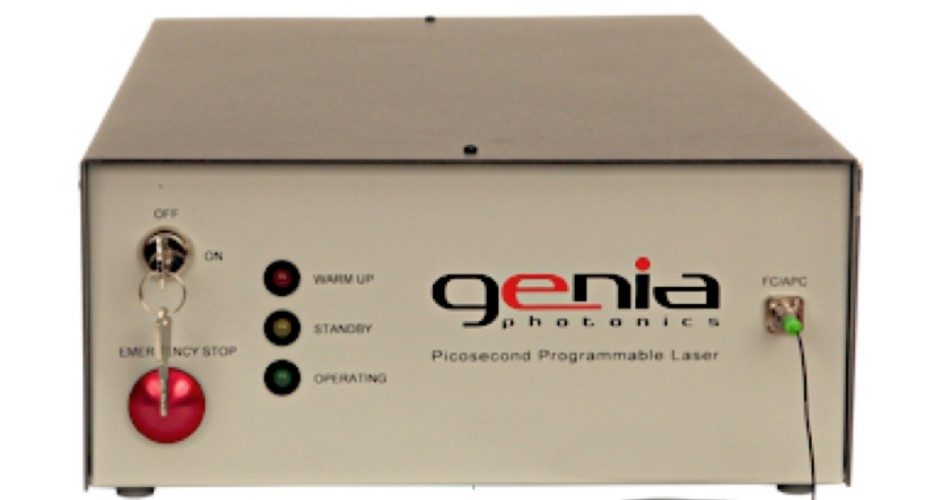
The latest piece of terrifying technology, the Picosecond Programmable Laser scanner from Genia Photonics, will be able to identify gunpowder residue on an individual’s shoes, and what he had for breakfast along with his adrenaline levels, according to the anonymous author of Gizmodo.com.
The portable unit, about the size of a breadbox, is described as “robust” and “mobile,” meaning it could not only be used in airports to supplement the invasions of privacy already being performed by the TSA but also in mobile units, such as police cruisers, roaming the streets, looking for suspicious “wavelength patterns and sequences.” According to anonymous:
The machine is ten million times faster—and one million times more sensitive—than any currently available system. That means that it can be used systematically on everyone passing through airport security, not just suspect or randomly sampled people…
The small, inconspicuous machine is attached to a computer running a program that will show the information in real time, from trace amounts of cocaine on your dollar bills to gunpowder residue on your shoes. Forget trying to sneak a bottle of water past security—they will be able to tell what you had for breakfast in an instant while you’re walking down the hallway.
All of this is being provided through a grant system set up in 1999 by the Central Intelligence Agency (CIA) when it was discovered that the agency was falling behind the technology curve and decided to do something about it. According to the CIA:
By the 1990s, however, especially with the advent of the World Wide Web, it is the commercial market that is setting the pace in IT [information technology] innovation. And, as is the nature of a market-based economy, the flow of capital and talent has irresistibly moved to the commercial sector, where the prospect of huge profits from initial public offerings and equity-based compensation has become the norm.
In contrast to the remarkable transformations taking place in Silicon Valley and elsewhere, the Agency, like many large Cold War era private sector corporations, felt itself being left behind. It was not connected to the creative forces that underpin the digital economy and, of equal importance, many in Silicon Valley knew little about the Agency’s IT needs. The opportunities and challenges posed by the information revolution to the Agency’s core mission areas of clandestine collection and all-source analysis were growing daily. Moreover, the challenges are not merely from foreign countries but also transnational threats [such as drug cartels].
And so, in coordination with Congress which provided some start-up funds, a quasi-private venture capital company was set up, called In-Q-Tel, with major intellectual input provided by Norman Augustine, former CEO at Lockheed Martin. A brilliant engineer, Augustine graduated magna cum Laude from Princeton with a bachelor’s and a master’s degree in Aeronautical Engineering. At age 30 he was working as Assistant Director of Defense Research and Engineering in the Defense Department, and inside ten years was Acting Secretary of the Army. He became CEO of Lockheed Martin when that company formed in 1995 and retired two years later. He remains active in the intelligence community and, not surprisingly, serves as a member of the Advisory Board to the Department of Homeland Security.
According to former CIA Director George Tenet, this is how it works:
We [the CIA] decided to use our limited dollars to leverage technology developed elsewhere. In 1999 we chartered … In-Q-Tel. … While we pay the bills, In-Q-Tel is independent of CIA. CIA identifies pressing problems, and In-Q-Tel provides the technology to address them.
The In-Q-Tel alliance has put the Agency back at the leading edge of technology … This … collaboration … enabled CIA to take advantage of the technology that Las Vegas uses to identify corrupt card players and apply it to link analysis for terrorists…and to adapt the technology that online booksellers use and convert it to scour millions of pages of documents looking for unexpected results. (emphasis added)
With its investment in Genia Photonics — among dozens of other advanced technology companies — the CIA has hit the surveillance jackpot. Exults the CIA:
Those of us at the Agency who helped to create In-Q-Tel are endlessly optimistic about its prospects for success. The early indicators are all positive…
Congress is to be congratulated for its support to the Agency as it launched this new venture. Congress seeded the venture with start-up funding when it was still in its conceptual phase…
With In-Q-Tel’s help plus the continued support of Congress and OMB, as well as from the traditional Agency contractor community and others, an “e-CIA” of the next century will evolve quickly, to the benefit of the President and the national security community. [Emphasis added.]
Notably missing from its boasting of its ability to co-op private technology for government surveillance purposes is any mention of potential threats to individual privacy. Any technology as advanced as this being provided to the CIA by Genia Photonics will be used without regard to the niceties of Constitutional limitations. It will be used simply because it can be. This will lead to what the anonymous writer at Gizmodo calls “observation without limits”:
There has so far been no discussion about the personal rights and privacy issues involved. Which “molecular tags” will they be scanning for? Who determines them? What are the threshold levels of this scanning?
If you unknowingly stepped on the butt of someone’s joint and are carrying a sugar-sized grain of cannabis … will you be arrested?
And, since it’s extremely portable, will this technology extend beyond the airport or border crossings and into police cars with officers looking for people on the street with increased levels of adrenaline in their system to detain in order to prevent potential violent outbursts?
And will your car be scanned at stoplights for any trace amounts of suspicious substances? Would all this information be recorded anywhere?
George Orwell would be proud. When he penned Nineteen Eighty-Four in 1949, he detailed the surveillance state being implemented with telescreens which could be turned down but never turned off. With the CIA’s success in capturing control of the latest technology through its surrogates such as Genia Photonics, the surveillance state is about to be turned on.



